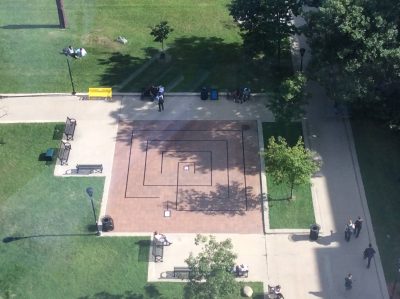By Maristela Petrovic-Dzerdz, Instructional Design Coordinator, EDC
Have you noticed the walking labyrinth in the quad recently?
We live in a very busy world where we are overwhelmed with distractions every minute. Technology enables us to be connected all the time, inducing anxiety caused by the fear that we might miss out on some very important information if we don’t check our devices regularly. This is a state we all live in and have gotten somewhat used to as a new norm, but unfortunately it is not necessarily healthy and is not conducive to deep learning, introspection or focusing, which are required for academic success.
These days, there has been a lot of talk about the state of our students’ mental health. I believe that we should all be searching for possible solutions that could contribute to the mental well being of our students, faculty and staff.
Last year at the Society for Teaching and Learning in Higher Education Annual Conference, I hosted a creative session on the parallels between a typical Hatha yoga class and Gagne’s Nine Events of Instruction, two topics very close to me as an instructional designer and certified Hatha yoga teacher. I pointed out that although we can find all the events of instruction Gagne listed in a typical, well designed Hatha yoga class, there is an important event in yoga class which precedes the other nine – and it is the “centering” or “tuning into practice.” I argued that in today’s world, adding this first event to every learning session, whether we study alone or in a group, is almost necessary to have a productive learning experience.
Luckily, just a day after my conference presentation, I attended one by Nina Johnson from Thompson Rivers University, on using labyrinths for introducing mindfulness to learners and educators. Right there I realized that it could be one solution to my quest. She talked about a Scholarship of Teaching and Learning (SoTL) project, which investigated the relationships between mindfulness practice using finger labyrinths and the potential to reduce student anxiety, improve concentration and enhance creativity.
“Labyrinths, which are ancient patterns large enough to be walked or small enough to be traced with the finger, represent tools for cultivating mindful habits. Mindfulness is the contemplative practice of focusing the attention on the present, non-judgmentally. By training the mind to remain fully present in each moment, the interior mental chatter that often plagues the mind becomes quiet, enhancing capacities or equanimity, clarity, and insight…Amid a culture that rewards speed and “busyness,” contemplative practice proposes a radical innovation for teaching and learning.” (Source: http://sched.co/3NFC ).
For over a year, I have wanted to create a walking labyrinth at Carleton University. The opportunity arose when I met the President, Dr. Runte, in August of this year. I was very pleasantly surprised at her interest and enthusiasm toward this idea, and within days I got the approval to build a temporary one. My selected space was in the quad, on the plateau in front of the library, since my office overlooks this space. Although the quad is a very busy place and not a secluded, meditative environment, my goal was to create a walking labyrinth installation that would raise awareness about the potential benefits of walking labyrinths, with a goal of having a permanent one installed somewhere on campus where students could spend a few minutes walking and calming the mind before embarking on hours of studying, or before an exam.
A team of enthusiastic helpers prepared and cleaned up the ground before taping the labyrinth, including Ryan Kuhne (EDC), Ana Avendano Zablah (EDC), Allie Davidson (EDC) and Norah Vollmer (Office of the Provost and Vice-President Academic).
We placed a poster with the explanation of the installation at the labyrinth entrance, and a Carleton crest logo at the center. I have envisioned that the “path in” represents a path to (Carleton) university and the “path out” represents how Carleton is preparing students to go back to the “outside world.”
Very quickly we had the first students who expressed interest in walking the labyrinth. The next morning, when I went to check on the installation before work, there was a student sitting in front of it, his eyes closed, meditating. I have seen students walking it alone and in a group, and a father kicking a ball with his daughter, by following the path. I have seen many people stopping and reading the poster.
My wish is that this idea gets traction and that interested groups will come forward in support of the initiative to build a permanent walking labyrinth at Carleton.
If you are interested in other places in Ottawa where you can find walking labyrinths, please check this website. There is a beautiful stone one at the Royal Ottawa Mental Health Centre.
Find out more about labyrinths and their benefits here.
